
Price based on lowest available cruise only fare for double occupancy. Subject to change at any time.
Norwegian Breakaway is ready to whisk you away to your best holiday yet. Take a Caribbean cruise and swim with dolphins, step back into history on a Mediterranean Cruise, or just enjoy relaxing days on a Transatlantic voyage. Named Best Cruise Ship for Families by USA Today, there's something on board for everyone. Breathe in the fresh ocean air and connect with the sea like never before along The Waterfront, a quarter-mile oceanfront promenade lined with restaurants, bars, and spectacular views. Indulge in more than 25 dining experiences, including three new, dedicated seafood venues. And enjoy dazzling performances - Six and Burn the Floor. Norwegian Breakaway offers magnificent amenities at sea.
Cruise ID: 25320
We are confident that you will enjoy your Freestyle Cruising experience and that our entire crew will provide you with the standard of service for which we are known. A discretionary service charge will be automatically added per guest per day (for guests three years and older) to your shipboard account for all staterooms: all ships US$ 16 per guest per day (for guests 3 years and older) for Studios, Inside, Oceanview and Balcony Staterooms. For Club Balcony Suites, the service charge will be US$ 18 per guest per day (for guests 3 years and older) and for Suites and The Haven Suites as well as the Concierge staterooms, the service charge will be US$ 20 per guest per day (for guests 3 years and older). This charge will be shared amongst those staff members, including the restaurant staff, stateroom stewards and other behind-the scenes staff who provide services that enhance your overall cruise experience.
These service charges can be paid in advance of your cruise. If you have any concerns about the service you receive during your cruise, please let our on-board Guest Services Desk staff know right away, so we can address any issues in a timely manner. In the unlikely event that we can't resolve your issue, you can have the service charge adjusted on board. Where your service charge has been pre-paid before departure, refunds are not available on board and you must apply for a refund, if applicable, after you return home by writing to our Guest Relations department.
Certain staff positions (e.g., concierge, butler, youth programme staff and beverage service) provide service on an individual basis to only some guests and do not benefit from the overall service charge. We encourage those guests to acknowledge good service from these staff members with appropriate gratuities.
Additionally, there is a 20% gratuity and spa service charge added for all spa and salon services, as well as a 20% gratuity and beverage service charge added for all beverage purchases and a 20% gratuity and speciality service charge added to all speciality restaurant dining and entertainment based dining e.g. Cirque Dreams® and Dinner (does not apply to Free at Sea dining and drinks packages).
| Date | Time | Price * | Booking |
|---|---|---|---|
| 23 December 2024 | 17:30 | €2,360 | Call us to book |
* Price based on lowest available cruise only fare for double occupancy. Subject to change at any time.
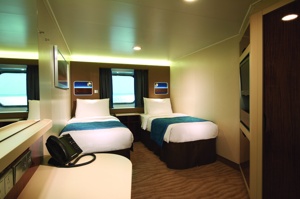
Enjoy a large picture window and two lower beds that convert to a queen-size bed.
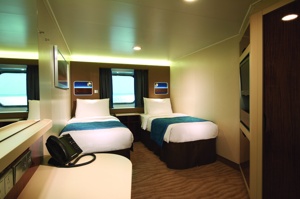
These staterooms feature a large round window and a queen-size bed. Staterooms are priced exclusively for solo travelers and include access to the private Studio Lounge.
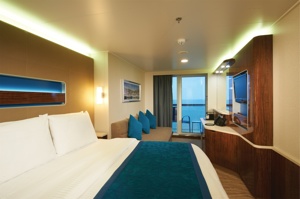
A Sail Away Balcony stateroom guarantees a Balcony stateroom or better! Please note that the view from your balcony may be fully obstructed or partially obstructed. Your stateroom may be on any deck and assigned up to one day prior to embarkation.
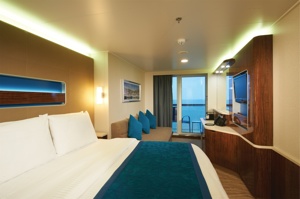
These spacious staterooms include a queen-size bed, sitting area and floor-to-ceiling glass doors that open onto a private balcony. Staterooms are priced exclusively for solo travelers and include access to the private Studio Lounge.
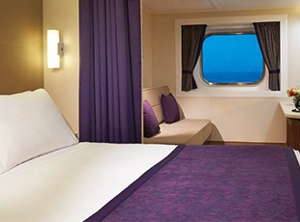
Perfect for families, these staterooms include two lower beds that convert to a queen-size bed, a bathtub in select rooms and additional bedding for up to 3. Accommodates up to five guests.
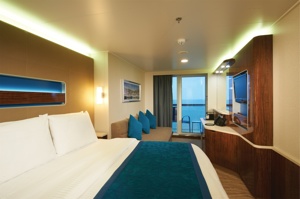
Take in the amazing views from these staterooms that include two lower beds that convert to a queen-size bed and additional bedding that can accommodate two guests. Some can connect to other staterooms, so you can enjoy your privacy yet stay close to friends or family.
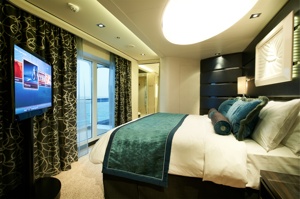
Located in The Haven, these Suites offer amazing ocean views, a living and dining area with wet bar and an extra-spacious wraparound balcony. They include a king-size bed that faces floor-to-ceiling windows, luxury bath, separate shower and two modern vanity sinks. Large wardrobe and dressing area with full closet, double sofa and guest half bathroom.
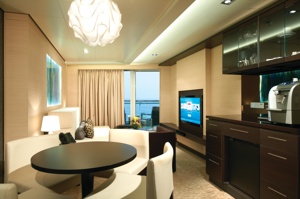
Comfort and luxury abound in this aft-facing, spacious Penthouse with a balcony that provides incredible views from the back of the ship. Features include a king size bed, luxury bath with bathtub and separate shower, living area, dining area and a guest bathroom with shower. Best of all, it has access to The Haven where you'll enjoy premium amenities including exclusive key card access to the Courtyard area, restaurant, lounge and 24-hour butler and concierge service. Some can connect to a Balcony Stateroom for even more room to spread out yet stay together.

These staterooms feature tranquil spa décor and include two lower beds that convert to a queen-size bed and a single sofa bed, easy access to the adjacent Mandara Spa experience and fitness centre, as well as complimentary access to the Thermal Suite during regular Spa hours.
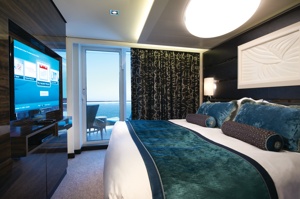
Marvel at the captain's view of the ocean in your private and luxurious Owner's Suite located in The Haven. This suite has a separate living and dining area with floor-to-ceiling views and 24-hour butler and concierge service. King-size bed with a luxury bath containing a bath tub and separate shower. Additional bedding that accommodates two and guest bathroom.
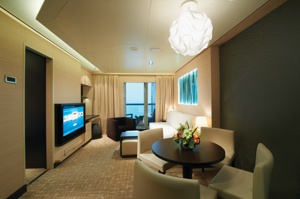
Perfect for the families, these suites offer plenty of space and privacy. The master bedroom has a king-size bed and a luxury bath with bathtub and separate shower. The second bedroom has a single sofa bed and bathroom with shower. Living and dining area with additional bedding to accommodate up to two guests. Experience amazing views from your private balcony.
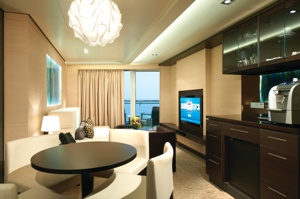
Located in the aft corners of decks 9 and 12, these Penthouse suites offer unforgettable views with floor to ceiling windows and extra large balconies. Indulge in the premium amenities of The Haven, with exclusive key card access to the Courtyard area, restaurant, lounge, 24-hour butler and concierge service. Featuring a king size bed, luxury bath with bathtub and separate shower, living area with double sofa bed, dining area and guest bathroom. Can connect to a Balcony Stateroom so you can spread out yet stay together.
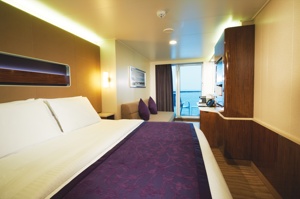
Featuring two beds that convert to a queen, extra bedding for two and a large, private balcony these Club Balcony Suites also offer amazing views. Enjoy the dining and excitement just steps away from The Waterfront.
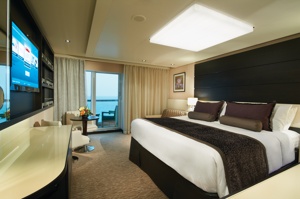
With exclusive key card access to The Haven and all its premium amenities, these Penthouses provide comfort and luxury with access to the secluded Courtyard Area, private restaurant and lounge. Featuring a king size bed, bath tub with shower (except in wheelchair accessible staterooms) and floor-to-ceiling glass doors that open to your private balcony. Two of these Penthouses can connect to The Haven Deluxe Owner's Suite with Large Balcony.
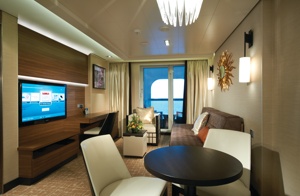
Get a bird's-eye view of the amazing vistas ahead from the serenity of your private balcony. Desirably located forward on the corners of decks 9-13, these Penthouses have exclusive key card access to The Haven Courtyard area, restaurant and lounge and 24-hour butler and concierge service. Featuring a king size bed, luxury bath with bathtub and separate shower, living area with single sofa bed and dining area. Some can connect to a Balcony Stateroom for even more space.
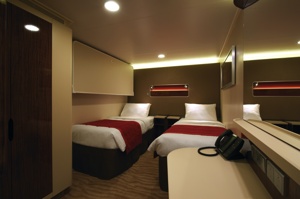
These staterooms include two lower beds that convert to a queen-size bed. Door opens to centre interior corridor for categories IA, IC & IF.

The perfect way to experience a total spa holiday, the Spa Suites include a king-size bed, jacuzzi, oversized waterfall shower and multiple body spray jets, spa décor, easy access to the adjacent Mandara Spa and fitness centre, as well as complimentary access to the Thermal Suite. Access to The Haven and all its premium amenities.
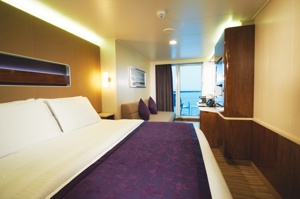
Family and friends, up to four total, will be comfortable with the extra space this mini-suite provides. Located on the upper decks, mid-ship or forward, it includes two lower beds that can convert to a queen, sleeper sofa, a sitting area and one bathroom/shower, some with a bathtub. Some can connect to a Club Balcony Suite or Balcony Stateroom so you can spread out yet stay close together.
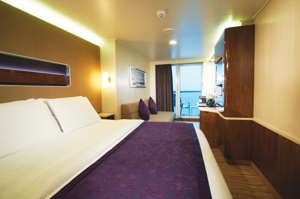
These Club Balcony Suites feature tranquil spa décor and includes two beds that convert to a queen, extra bedding for additional guest(s), oversized waterfall shower and multiple body spray jets, easy access to the adjacent Mandara Spa and fitness centre, as well as complimentary access to the Thermal Suite during regular Spa hours.
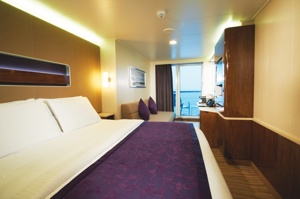
A Sail Away Club Balcony Suite stateroom guarantees a Club Balcony Suite stateroom or better! Your stateroom may be on any deck and assigned up to one day prior to embarkation.
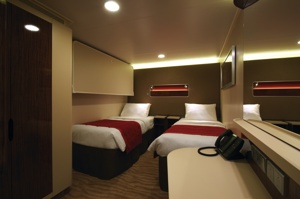
A Sailaway Inside stateroom guarantees an Inside stateroom or better! Your stateroom may be on any deck and assigned between time of booking up to one day prior to embarkation.
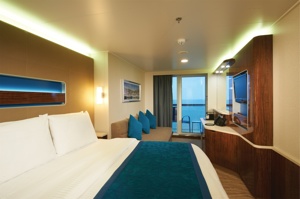
Ideal for the whole family, these staterooms are conveniently located near the kids' area and include two lower beds that convert to a queen-size bed, an upper bed and a sofa bed. Many can connect to other staterooms, so you have the option to spread out yet stay together.
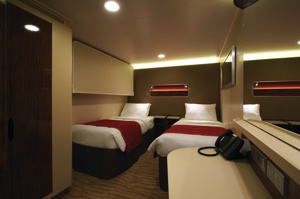
An affordable family option and conveniently located near our kids' area, these staterooms include two lower beds that convert to a queen-size bed and two pull-down beds. Some can connect to other staterooms, giving you even more room to spread out. (Door opens to centre interior corridor.)
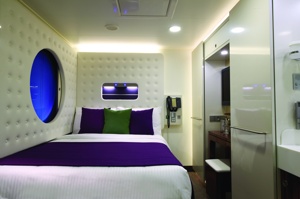
Private keycard access complex comprised of staterooms specifically designed and priced for the solo traveller. Featuring a full-size bed, a one-way window to the corridor, and separate areas for your bathroom, sink and shower, in 100 square feet of living space. Includes access to the private Studio Lounge. Plus, some Studios can connect to each other so you can stay close yet still enjoy your privacy. No single supplement required.
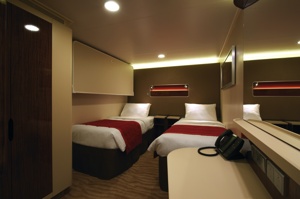
These staterooms include a queen-size bed and the same amenities as other inside staterooms. Staterooms are priced exclusively for solo travelers and include access to the private Studio Lounge.
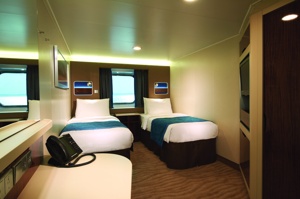
A Sail Away Oceanview stateroom guarantees an Oceanview stateroom or better! Please note that the view may be fully obstructed, partially obstructed, porthole or picture window. Your stateroom may be on any deck and assigned up to one day prior to embarkation.
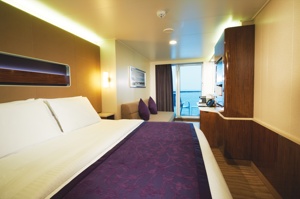
These Club Balcony Suites have plenty of room for you to spread out with two beds that convert to a queen and a large aft-facing balcony to take in the amazing views.
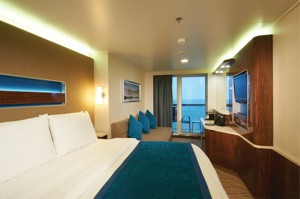
These staterooms include two lower beds that convert to a queen-size bed and are aft-facing, so the view from your private balcony is amazing.
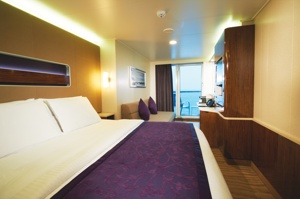
Up to four guests can enjoy the extra space this Club Balcony Suite provides. Located mid-ship or forward, it includes two lower beds that can convert to a queen, foldable sleeper, and one bathroom with shower, some with a bathtub.
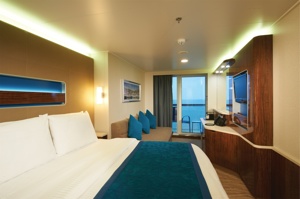
These staterooms have a large balcony offering incredible views, two lower beds that convert to a queen-size bed and additional bedding to sleep one or two more.
Day 1 Miami, Florida, United States
Miami is one of the world's most popular holiday spots. It has so much to offer; from its countless beach areas, to culture and museums, from spa and shopping days out, to endless cuban restaurants and cafes. Miami is a multicultural city that has something to offer to everyone.
Day 2 Cruising
Day 3 Puerto Plata, Dominican Republic
San Felipe de Puerto Plata is the capital of the Puerto Plata province on the Dominican Republic's Atlantic north coast. The city is best known for its beaches. Playa Dorada's lengthy beachfront is backed by resorts and an 18-hole golf course. The city's old colonial-era center is dominated by the 16th-century Fortaleza San Felipe, a Spanish fortress that now houses historical and military artifacts.
Day 4 San Juan (Puerto Rico), Puerto Rico
If you associate Puerto Rico's capital with the colonial streets of Old San Juan, then you know only part of the picture. San Juan is a major metropolis, radiating out from the bay on the Atlantic Ocean that was discovered by Juan Ponce de León. More than a third of the island's nearly 4 million citizens proudly call themselves sanjuaneros. The city may be rooted in the past, but it has its eye on the future. Locals go about their business surrounded by colonial architecture and towering modern structures.By 1508 the explorer Juan Ponce de León had established a colony in an area now known as Caparra, southeast of present-day San Juan. He later moved the settlement north to a more hospitable peninsular location. In 1521, after he became the first colonial governor, Ponce de León switched the name of the island—which was then called San Juan Bautista in honor of St. John the Baptist—with that of the settlement of Puerto Rico ("rich port").Defended by the imposing Castillo San Felipe del Morro (El Morro) and Castillo San Cristóbal, Puerto Rico's administrative and population center remained firmly in Spain's hands until 1898, when it came under U.S. control after the Spanish-American War. Centuries of Spanish rule left an indelible imprint on the city, particularly in the walled area now known as Old San Juan. The area is filled with cobblestone streets and brightly painted, colonial-era structures, and its fortifications have been designated a UNESCO World Heritage Site.Old San Juan is a monument to the past, but most of the rest of the city is planted firmly in the 21st century and draws migrants island-wide and from farther afield to jobs in its businesses and industries. The city captivates residents and visitors alike with its vibrant lifestyle as well as its balmy beaches, pulsing nightclubs, globe-spanning restaurants, and world-class museums. Once you set foot in this city, you may never want to leave.
Day 5 Saint Thomas, U.S. Virgin Islands
If you fly to the 32-square-mile (83-square-km) island of St. Thomas, you land at its western end; if you arrive by cruise ship, you come into one of the world's most beautiful harbors. Either way, one of your first sights is the town of Charlotte Amalie. From the harbor you see an idyllic-looking village that spreads into the lower hills. If you were expecting a quiet hamlet with its inhabitants hanging out under palm trees, you've missed that era by about 300 years. Although other islands in the USVI developed plantation economies, St. Thomas cultivated its harbor, and it became a thriving seaport soon after it was settled by the Danish in the 1600s. The success of the naturally perfect harbor was enhanced by the fact that the Danes—who ruled St. Thomas with only a couple of short interruptions from 1666 to 1917—avoided involvement in some 100 years' worth of European wars. Denmark was the only European country with colonies in the Caribbean to stay neutral during the War of the Spanish Succession in the early 1700s. Thus, products of the Dutch, English, and French islands—sugar, cotton, and indigo—were traded through Charlotte Amalie, along with the regular shipments of slaves. When the Spanish wars ended, trade fell off, but by the end of the 1700s Europe was at war again, Denmark again remained neutral, and St. Thomas continued to prosper. Even into the 1800s, while the economies of St. Croix and St. John foundered with the market for sugarcane, St. Thomas's economy remained vigorous. This prosperity led to the development of shipyards, a well-organized banking system, and a large merchant class. In 1845 Charlotte Amalie had 101 large importing houses owned by the English, French, Germans, Haitians, Spaniards, Americans, Sephardim, and Danes. Charlotte Amalie is still one of the world's most active cruise-ship ports. On almost any day at least one and sometimes as many as eight cruise ships are tied to the docks or anchored outside the harbor. Gently rocking in the shadows of these giant floating hotels are just about every other kind of vessel imaginable: sleek sailing catamarans that will take you on a sunset cruise complete with rum punch and a Jimmy Buffett soundtrack, private megayachts for billionaires, and barnacle-bottom sloops—with laundry draped over the lifelines—that are home to world-cruising gypsies. Huge container ships pull up in Sub Base, west of the harbor, bringing in everything from breakfast cereals to tires. Anchored right along the waterfront are down-island barges that ply the waters between the Greater Antilles and the Leeward Islands, transporting goods such as refrigerators, VCRs, and disposable diapers. The waterfront road through Charlotte Amalie was once part of the harbor. Before it was filled in to build the highway, the beach came right up to the back door of the warehouses that now line the thoroughfare. Two hundred years ago those warehouses were filled with indigo, tobacco, and cotton. Today the stone buildings house silk, crystal, and diamonds. Exotic fragrances are still traded, but by island beauty queens in air-conditioned perfume palaces instead of through open market stalls. The pirates of old used St. Thomas as a base from which to raid merchant ships of every nation, though they were particularly fond of the gold- and silver-laden treasure ships heading to Spain. Pirates are still around, but today's versions use St. Thomas as a drop-off for their contraband: illegal immigrants and drugs. To explore outside Charlotte Amalie, rent a car or hire a taxi. Your rental car should come with a good map; if not, pick up the pocket-size "St. Thomas–St. John Road Map" at a tourist information center. Roads are marked with route numbers, but they're confusing and seem to switch numbers suddenly. Roads are also identified by signs bearing the St. Thomas–St. John Hotel and Tourism Association's mascot, Tommy the Starfish. More than 100 of these color-coded signs line the island's main routes. Orange signs trace the route from the airport to Red Hook, green signs identify the road from town to Magens Bay, Tommy's face on a yellow background points from Mafolie to Crown Bay through the north side, red signs lead from Smith Bay to Four Corners via Skyline Drive, and blue signs mark the route from the cruise-ship dock at Havensight to Red Hook. These color-coded routes are not marked on most visitor maps, however. Allow yourself a day to explore, especially if you want to stop to take pictures or to enjoy a light bite or refreshing swim. Most gas stations are on the island's more populated eastern end, so fill up before heading to the north side. And remember to drive on the left!
Day 6 Saint John's, Antigua and Barbuda
With its superb beaches, historical attractions and beautiful coral reefs, Antigua provides a host of diversions. It is said that the island contains 365 beaches, one for every day of the year. Antigua maintains its traditional West Indian character, with gingerbread-house style architecture, calypso music and carnival festivities. St John's has been the administrative capital since the island's colonisation in 1632, and has been the seat of government since it gained independence in 1981. From the port you can explore the colourful Redcliffe district, with its restored wooden houses, and Heritage Quay with its shopping mall and craft shops. The city has some fine examples of Colonial architecture, including the twin-towered cathedral, built in 1845 and considered one of the finest church buildings in the Caribbean. All coaches in Antigua are operated by smaller vehicles, and commentary will be given by a driver/guide.
Day 7 Philipsburg, Sint Maarten (Dutch part)
The capital of Dutch St. Maarten stretches about a mile (1½ km) along an isthmus between Great Bay and the Salt Pond and has five parallel streets. Most of the village's dozens of shops and restaurants are on Front Street, narrow and cobblestone, closest to Great Bay. It's generally congested when cruise ships are in port, because of its many duty-free shops and several casinos. Little lanes called steegjes connect Front Street with Back Street, which has fewer shops and considerably less congestion. Along the beach is a ½-mile-long (1-km-long) boardwalk with restaurants and several Wi-Fi hot spots.Wathey Square (pronounced watty) is in the heart of the village. Directly across from the square are the town hall and the courthouse, in a striking white building with cupola. The structure was built in 1793 and has served as the commander's home, a fire station, a jail, and a post office. The streets surrounding the square are lined with hotels, duty-free shops, restaurants, and cafés. The Captain Hodge Pier, just off the square, is a good spot to view Great Bay and the beach that stretches alongside.
Day 8 Road Town, Tortola, British Virgin Islands
Day 9 Cruising
Day 10 Great Stirrup Cay, Bahamas
Located 50 miles from Nassau, Great Stirrup Cay is a 250-acre island owned by Norwegian Cruise Line. A range of activities are on offer, including water sports, ping-pong, beach volleyball and a water slide. For lunch, the Jumbey Beach Grill offers barbecues on the beach. Afterwards, head to the Berried Treasure Bazaar to find a little something to bring back home.
Day 11 Miami, Florida, United States
Miami is one of the world's most popular holiday spots. It has so much to offer; from its countless beach areas, to culture and museums, from spa and shopping days out, to endless cuban restaurants and cafes. Miami is a multicultural city that has something to offer to everyone.
The Department of Foreign Affairs has up-to-date advice for Irish citizens on staying safe and healthy abroad. For more security, local laws, health, passport and visa information see https://www.dfa.ie/travel/travel-advice/ and follow dfatravelwise